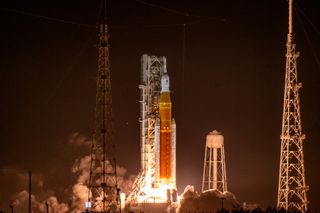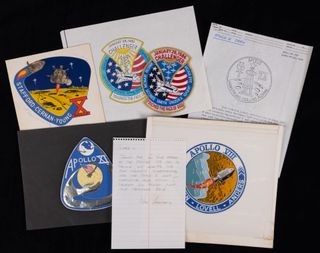Caption: The Intuitive Machines lunar lander that will deliver NASA science and technology to the Moon as part of the agency’s CLPS (Commercial Lunar Payload Services) initiative and Artemis campaign is encapsulated in the fairing of the SpaceX Falcon 9 rocket. Credit: SpaceX Carrying NASA science and technology to the Moon as part of the agency’s CLPS (Commercial Lunar Payload Services) initiative and Artemis campaign, the Intuitive Machines IM-2 mission is targeted to launch no earlier than Wednesday, Feb. 26. The mission will lift off on a SpaceX Falcon 9…
Read MoreTag: Missions
Guiding Orion: Jorge Chong’s Mission to Advance Deep Space Exploration
Jorge Chong is helping shape the future of human spaceflight, one calculation at a time. As a project manager for TRON (Tracking and Ranging via Optical Navigation) and a guidance, navigation, and control (GNC) test engineer in the Aeroscience and Flight Mechanics Division, he is leading efforts to ensure the Orion spacecraft can navigate deep space autonomously. Jorge Chong in front of the Mission Control Center at NASA’s Johnson Space Center in Houston when he helped with optical navigation operations during Artemis I. Image courtesy of Jorge Chong “GNC is…
Read MoreThe ISS should be deorbited ‘as soon as possible,’ Elon Musk says: ‘Let’s go to Mars’
Elon Musk thinks we should start moving on from the International Space Station (ISS). “It is time to begin preparations for deorbiting the @Space_Station. It has served its purpose. There is very little incremental utility. Let’s go to Mars,” the SpaceX chief and close Trump adviser said via X today (Feb. 20). In another X post, he laid out his preferred timeline: “The decision is up to the President, but my recommendation is as soon as possible. I recommend 2 years from now.” NASA and its partners on the ISS…
Read MoreLeaving Pluto in the dust: New Horizons probe gearing up for epic crossing of ‘termination shock’
NASA’s New Horizons spacecraft conducted the first and only flyby of the Pluto system, culminating at the closest approach of that distant world in July 2015. Sailing onward, the probe carried out a Jan. 1, 2019 flyby of Arrokoth, a Kuiper Belt Object, or KBO, located in a region of space beyond Neptune called the Kuiper Belt. There are scads of other icy worlds residing in the Kuiper Belt, celestial leftovers from the formation of our solar system. For New Horizons, the gathering of more exploration science is, pun intended,…
Read MoreBoeing plans to lay off hundreds of employees working on NASA’s SLS moon rocket: reports
Boeing is preparing to issue layoff notices to roughly 200 employees working on the Space Launch System (SLS) — the massive rocket central to NASA’s flagship Artemis program — as it braces for the possibility that its contracts with the space agency may not be renewed after they end in March. Of the approximately 400 positions Boeing initially considered cutting by April “to align with revisions to the Artemis program and cost expectations,” the company managed to preserve half of the jobs after daily talks with NASA, Boeing’s Vice President…
Read MoreBoeing Starliner astronauts on the ISS set the story straight: ‘We don’t feel stranded’
Boeing’s Starliner astronauts are in the final stretch of their unexpectedly long stint in Earth orbit — and they’re setting the record straight on all the “stranded astronauts” talk. NASA’s Suni Williams and Butch Wilmore launched to the International Space Station (ISS) last June on the first crewed test flight of Boeing’s Starliner spacecraft. The duo expected their orbital stay to last about 10 days, but Starliner experienced thruster malfunctions during its approach and docking maneuvers. This led to an extensive investigation by NASA and Boeing back on the ground,…
Read MoreRisks with current Artemis 3 moon landing plan ‘may be too high,’ NASA safety group says
An annual safety report to NASA has both praise for the agency and also underscores a number of cautionary woes, including the space agency’s undertaking of the Artemis back-to-the-moon with humans campaign. The annual report from the Aerospace Safety Advisory Panel (ASAP) has been released. The report observes that NASA has made impressive progress. Challenges remain, however, and are highlighted in this report. Of note, this report points to significant safety observations for both the agency’s Moon to Mars Program and the current International Space Station operations in low-Earth orbit.…
Read MoreAuction offers Neil Armstrong’s reply to NASA engineer’s Apollo 11 mission patch ideas
Neil Armstrong was appreciative, but as explained in his handwritten letter, it was too late. The Apollo 11 commander and his crewmates had already arrived at a design to represent the first moon landing. Armstrong’s note and the mission patch proposal that inspired it are up for auction in Goldberg Coins & Collectibles’ Feb. 27 public sale in Los Angeles. The emblem art and first moonwalker‘s reply are part of the Clark C. McClelland collection, an archive of astronaut autographs, cscale rocket models and flown memorabilia from the estate of…
Read MoreNASA will beam Super Bowl LIX to orbit for astronauts aboard the International Space Station
Are you ready to catch the big game? On Sunday (Feb. 9), across the United States and around the world, Americans and American football fans will tune in to watch the top two teams in the National Football League (NFL) go head-to-head in the ultimate post-season game, and even astronauts living in space will have the chance to watch the action live. Sunday evening, the American Football Conference (AFC) champions, the Kansas City Chiefs, will face off against the National Football Conference (NFC) champions, the Philadelphia Eagles, in Super Bowl…
Read MorePutin axes Yuri Borisov, head of Russia’s space agency
Russia has a new space chief. Russian President Vladimir Putin has dismissed Yuri Borisov after 2.5 years in charge of the nation’s space agency Roscosmos, The Moscow Times reported today (Feb. 6). His replacement is 39-year-old Dmitry Bakanov, who most recently served as Russia’s deputy transport minister and led the state-backed Gonets satellite communications system from 2011 to 2019. New Roscosmos chief Dmitry Bakanov, at the time deputy minister of transport of the Russian Federation, attends a session on “LET’S GO: Integrated Unmanned Freight Transport Hits the Motorway for the…
Read More








